As autumn temperatures begin dropping across the UK, many motorists start questioning whether their vehicle’s battery will survive another harsh winter. Battery failures spike dramatically during cold weather, leaving countless drivers stranded with non-starting vehicles on frosty mornings. Understanding when battery replacement becomes necessary before winter arrives can save you from inconvenient breakdowns and costly emergency callouts.
How Cold Weather Affects Battery Performance
Car batteries operate through electrochemical reactions that slow significantly as temperatures drop. At freezing point, a typical battery loses approximately 20% of its capacity, whilst sub-zero conditions can reduce available power by up to 50%. This dramatic reduction occurs precisely when your engine requires maximum starting power to overcome thickened engine oil and increased internal resistance.
Modern vehicles compound this challenge with increased electrical demands. Heated seats, rear window demisters, powerful headlights, and climate control systems all draw substantial current during winter months. These accessories can overwhelm already compromised battery capacity, leading to starting failures even with moderately worn batteries.
The charging system also faces winter challenges. Short journeys common during winter months rarely allow sufficient charging time to fully replenish battery capacity. Combined with reduced alternator efficiency in cold conditions, batteries often operate in a partially discharged state throughout winter, accelerating deterioration and increasing failure risk.
Temperature fluctuations between day and night create additional stress on battery components. Repeated expansion and contraction can damage internal plates and connections, whilst condensation can dilute electrolyte concentration, further reducing capacity and performance.
Assessing Your Current Battery Condition
Professional battery testing provides the most reliable assessment of winter readiness. Modern battery testers measure not only voltage but also cold cranking amps (CCA) and internal resistance, providing comprehensive evaluation of battery health and remaining capacity.
A battery showing reduced CCA ratings may start your vehicle adequately during mild weather but fail completely when temperatures plummet. Testing reveals this deterioration before winter arrives, allowing planned replacement rather than emergency roadside assistance.
Visual inspection can reveal obvious problems requiring immediate attention. Corrosion around terminals, cracked battery cases, or bulging sides indicate internal damage or electrolyte leakage. These symptoms suggest imminent failure regardless of testing results.
Battery age represents another critical factor in winter readiness assessment. Most car batteries last three to five years under normal conditions, but harsh winters, frequent short journeys, and extreme temperatures can significantly reduce lifespan. Batteries approaching four years old deserve particular scrutiny before winter.
Check your battery’s manufacture date, typically stamped on the case or indicated by coded markings. If your battery exceeds three years old and shows any performance concerns, replacement before winter provides valuable insurance against breakdown.
Warning Signs Indicating Battery Replacement
Several symptoms indicate battery deterioration that could lead to winter failure. Slow engine cranking, particularly on cold mornings, suggests reduced battery capacity that will worsen as temperatures drop further.
Dashboard warning lights, including battery or charging system indicators, require immediate professional attention. These warnings often appear before complete battery failure, providing opportunity for planned replacement rather than emergency breakdown.
Electrical system irregularities, such as dim headlights, flickering dashboard lights, or sluggish power window operation, can indicate insufficient battery capacity to meet electrical demands. These symptoms typically worsen during winter when electrical loads increase.
Repeated jump-start requirements clearly indicate battery problems requiring immediate attention. Batteries needing frequent assistance rarely recover sufficiently to provide reliable winter service.
Interior lights dimming when starting the engine suggests marginal battery capacity that may prove inadequate during cold weather starting demands. This symptom becomes particularly concerning as winter approaches.
The Economics of Preventive Battery Replacement
Replacing a battery before complete failure typically proves more economical than emergency replacement following breakdown. Planned replacement allows shopping for competitive prices and quality products rather than accepting whatever’s available during emergency situations.
Emergency callout charges for jump-starting or battery replacement often exceed the cost difference between planned and emergency replacement. These charges increase during winter months when demand peaks and weather conditions complicate service calls.
Consider the inconvenience factor when evaluating replacement timing. Winter breakdowns often occur during the worst possible circumstances—early morning commutes, school runs, or essential appointments. The stress and disruption caused by unexpected battery failure often outweigh modest cost savings from delaying replacement.
Quality battery replacement during autumn allows proper installation and system testing before extreme weather arrives. This timing ensures optimal performance when you need it most, rather than hoping a marginal battery survives another winter.
Factors Influencing Battery Longevity
Driving patterns significantly affect battery lifespan and winter readiness. Frequent short journeys prevent full battery charging, leading to sulphation and premature capacity loss. If your typical journeys last less than 20 minutes, your battery faces additional stress requiring more frequent assessment.
Vehicle age and electrical system complexity influence battery demands. Older vehicles with original electrical systems typically place lower demands on batteries, whilst modern cars with extensive electronic systems require batteries maintaining full capacity to operate reliably.
Climate exposure affects battery deterioration rates. Vehicles parked outdoors experience greater temperature extremes than those stored in garages, accelerating chemical deterioration and reducing overall lifespan.
Maintenance history plays a crucial role in battery condition. Regular cleaning of terminals, checking electrolyte levels in serviceable batteries, and ensuring proper charging system operation all extend battery life and improve winter reliability.
Professional Battery Services and Winter Preparation
Professional battery testing provides comprehensive assessment beyond simple voltage checks. Advanced testing equipment evaluates internal resistance, conductance, and load capacity, predicting potential winter failures before they occur.
Battery replacement involves more than simply swapping old for new. Proper installation requires terminal cleaning, correct torque specifications, and charging system verification to ensure optimal performance and longevity.
Many modern vehicles require battery registration or adaptation procedures following replacement. Professional workshops possess the diagnostic equipment necessary to complete these procedures, ensuring proper operation of engine management and electrical systems.
Comprehensive winter preparation extends beyond battery replacement to include charging system inspection, starter motor assessment, and electrical connection cleaning. These services ensure your entire starting system operates reliably throughout winter months.
Alternative Solutions for Marginal Batteries
If testing reveals marginally adequate battery condition, several strategies can improve winter reliability without immediate replacement. Battery maintainers or trickle chargers can maintain full charge during periods of reduced use, extending battery life and improving cold weather performance.
Engine block heaters reduce starting loads by maintaining optimal oil temperature, allowing marginal batteries to start vehicles more reliably during extreme cold. This solution proves particularly valuable for diesel engines or vehicles parked outdoors.
Carrying jump leads or portable battery boosters provides emergency starting capability should your battery fail unexpectedly. However, this approach addresses symptoms rather than preventing problems and may leave you stranded in remote locations.
Making the Right Decision for Your Situation
The decision to replace your battery before winter depends on multiple factors including battery age, test results, driving patterns, and personal risk tolerance. However, batteries showing any signs of deterioration warrant replacement before winter’s arrival.
Consider your vehicle’s role in your daily routine when making replacement decisions. If your car is essential for work commutes, school runs, or caring responsibilities, battery reliability becomes particularly important during winter months.
At First Auto Centre, our experienced technicians provide comprehensive battery testing and honest advice about replacement timing. We understand that battery replacement represents a significant expense and strive to provide accurate assessments helping you make informed decisions about winter preparation.
Conclusion
While not every battery requires replacement before winter, proactive assessment and timely replacement prevent the majority of cold weather starting problems. The inconvenience and expense of winter breakdown typically exceed the cost of preventive battery replacement, making autumn battery evaluation a wise investment in reliable winter motoring.
Professional battery testing provides the information necessary to make informed replacement decisions, ensuring your vehicle starts reliably throughout the challenging winter months ahead.








